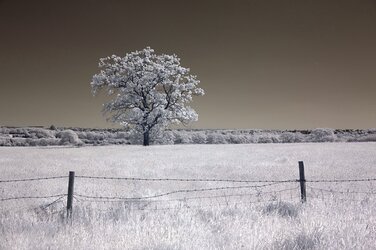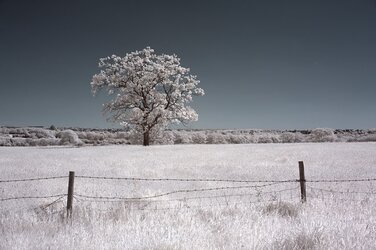- Joined
- Mar 7, 2008

As discussed in another thread, human eyes can detect near infrared. This is red light just beyond our normal vision, perhaps in the ball park of 700 to 1000nm or so. I don't know what the actual sensitivity is. Normally we can't see it, as the sensitivity is low, and visible light will swamp it. I should add, if you have "night vision" mode on a camera, this is likely what it is looking for. It will come with its own NIR emitters which can look like a faint red if you look directly at them. A colour camera similarly can detect it, with the majority of the energy in the red channel. The above image is a simulated version of a photo I took at my local park. I have the source somewhere, but it is quicker to replicate than to locate the original file. If you can obtain or make a filter to block out visible light, this is indicative of what you could see too. For reasons I don't know, "green" plant matter is very reflective of this infrared, so on a sunlit day you can see quite well.
To make such a filter at low cost, you can buy big sheets of lighting gels from the likes of Amazon relatively cheap. These are used to colour lights for effect, and have a design characteristic that they pass infrared light regardless of their visible colours. This is because before the advent of high efficiency light technology, lights run very hot. If it didn't pass the IR, it would heat up and get damaged or worse. You simply need two different colours in visible light, and the combo I used to make cheap goggles were primary red, and congo blue. By experimenting, I found about 3 layers of each stacked together gave an effective filter. I would caution here, I don't know how much UV might be passed. This probably isn't safe for any duration. As always, never look directly at the sun.
Oh, NIR is also typically used for most remote controls. If you point a remote at a smartphone camera, and press a remote button, you can often see it flashing. The phone cameras are also sensitive to this.

Now, you might say, why do this at all? As I said, most of the energy is in the red channel of a camera. Not all. Some of it goes into the green and blue channels too. When I tried to analyse it, I find the wavelengths are kinda reversed here. Red channel will see NIR closest to visible red. Onto longer wavelengths, green has higher (relative) sensitivity than the other channels. Similarly for blue at longer wavelengths. Different objects show relative different quantities of NIR. If you poke about with the white balance a LOT, you get this image above. Not bad?

And an IR photographer's final trick - swap the red and blue channels. This restores the blue sky that is expected, yet you get this white landscape. This is a niche photography style people play with now and then. I actually modified one camera just to do this. Just buy the cheapest DSLR you can use, and remove the IR blocking filter that is normally there to prevent this from ruining normal photos. Then apply another filter, preferably better than the lighting gels, and away you go. There are commercially made IR filters, although ideally they should be more clearly called IR pass filters.